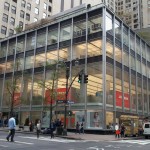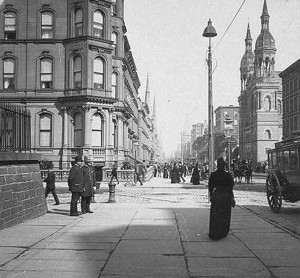Fifth Avenue & 42nd Street circa 1897
 By the shadows we can see it is morning on a somewhat chilly day in the heart of Manhattan in about 1897. We are looking north up Fifth Avenue from the corner of 42nd Street. Pedestrians stroll on the flagstone sidewalks while horse drawn vehicles make their way up and down the avenue.
By the shadows we can see it is morning on a somewhat chilly day in the heart of Manhattan in about 1897. We are looking north up Fifth Avenue from the corner of 42nd Street. Pedestrians stroll on the flagstone sidewalks while horse drawn vehicles make their way up and down the avenue.
On the extreme left the small wall with the iron fence marks the perimeter of the Croton Distributing Reservoir also known as the Murray Hill Reservoir, on the west side of Fifth Avenue between 40th and 42nd Streets. Beyond the fence, stood massive walls 25 feet thick and over 50 feet high which when filled to capacity held 21 million gallons of water. The old reservoir served New York’s thirsty population from 1842 until it was taken out of service in 1897. The structure was demolished in 1900 and the main branch of the New York Public Library now stands on the site.
On the same corner we see an old fashioned fire hydrant and new electric lamppost standing next to what appears to be a gas lamp.
Just to the right of the wall a policeman chats another man perhaps a plain clothes detective as they look east across 42nd Street. The building just behind them is the eight story Hotel Bristol. In 1903 the hotel would be converted to the Bristol Building.
After the Bristol was demolished the art deco 59 story skyscraper, 500 Fifth Avenue Building, would go up on the site between 1929-1931. 500 Fifth Avenue was built by Shreve, Lamb & Harmon the same architects of the Empire State Building, also completed in 1931.
Next to the Hotel Bristol we see a glimpse of the seven story Hotel Renaissance built in the obligatory French Renaissance style and completed in 1891. Though the hotel was designed with the intention of attracting a “high class family and bachelor clientele” there were a certain class of people that were not welcome.
In 1907 George H. Abbott, a lawyer, agreed to a lease an apartment at the Renaissance, but before occupying the apartment he had a change of plans and rented elsewhere. Abbott needed to get out of his Renaissance commitment and the hotel management agreed to release him from his lease if Abbott could provide some other tenant with “undoubted and equal financial responsibility” to take over the lease.
Abbott advertised the available apartment and real estate investor Walter J. Salomon agreed to take up the rental. This arrangement was nixed by hotel manager William Watson when he refused to rent the room to Salomon saying Renaissance owner David H. King Jr. would not take Jews as tenants.
Abbott thought this outrageous. Salomon was a respectable and responsible tenant and Abbott was now deprived of his only opportunity to sublet. Abbott and Watson became embroiled in a lawsuit as the hotel insisted Abbott pay for the vacant apartment.
After a short trial, the court ruled against the hotel with Justice Wauhope Lynn deciding it was, “un-American to exclude a man from a hotel because of his race or creed.” Justice Lynn said the “hotel management’s contention was obnoxious to law and contrary to fact.” Salomon’s friends suggested he sue the hotel as well, but Salomon demurred saying he had no desire to go where he was not wanted.
The Renaissance Hotel was sold in 1917 and converted to a high end office building with two stories added and renamed the Ziegler Building after its new owner William Ziegler Jr..
That building was demolished in 1952 and replaced by a glass five story structure by architect Gordon Bunshaft of Skidmore, Owings & Merrill for Manufacturers Trust Company Bank. The boldly designed exterior was declared a landmark in 1997 by the Landmarks Preservation Commission.
Walter J. Salomon later changed his name to Salmon and became a big-wig in the area when he bought and demolished the Hotel Bristol to build the aforementioned 500 Fifth Avenue Building.
On the east side of Fifth Avenue and 43rd Street the building with the twin cupolas is the Moorish styled Temple Emanu-El, considered by many contemporary architectural critics to have been the most beautiful synagogue in the United States.
The congregation sold their valuable real estate in 1926 for over $6 million dollars and moved uptown to its current building on 65th Street and Fifth Avenue in 1929.
We end where we began. This is the same photo we led off the story with however instead of sepia, here it is in black and white with different clarity.








We have an old glass negative of this Croton reservoir building in 1897
42nd St. & 5th Ave..New York. Still in prestine condition.